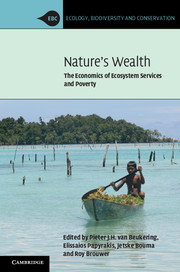Book contents
- Frontmatter
- Contents
- List of contributors
- Acknowledgements
- 1 The economics of ecosystem services and poverty
- Part I Biodiversity-related ecosystem services
- Part II Marine-related ecosystem services
- Part III Forest-related ecosystem services
- Part IV Water-related ecosystem services
- Part V Land-related ecosystem services
- Index
- References
1 - The economics of ecosystem services and poverty
Published online by Cambridge University Press: 05 July 2013
- Frontmatter
- Contents
- List of contributors
- Acknowledgements
- 1 The economics of ecosystem services and poverty
- Part I Biodiversity-related ecosystem services
- Part II Marine-related ecosystem services
- Part III Forest-related ecosystem services
- Part IV Water-related ecosystem services
- Part V Land-related ecosystem services
- Index
- References
Summary
Introduction
Ecosystems play a crucial role in the survival and well-being of human beings. Increasing pressure on ecosystems resulting from economic development and population growth has resulted in degrading ecosystems and losses of the services ecosystems provide throughout the world. According to the UN (2010) ‘as a consequence of human actions, species are being lost at a rate estimated to be 100 times the natural rate of extinction. In the past century, 35% of the mangroves, 40% of the forests and 50% of the wetlands have been lost . . . action is urgently needed to avoid reaching critical thresholds that will lead to an irreversible loss of biodiversity and ecosystem services, with dangerous consequences for human well-being’.
The Millennium Ecosystem Assessment (MEA) (2005) was the first to explicitly underline the linkages between ecosystems and human well-being, coining the term ‘ecosystem services’ to stress the important benefits that people derive from ecosystems (MEA 2005). The term ‘Ecosystem Services’ serves as a catalyst to stress the importance of ecosystems for human well-being. As indicated in Figure 1.1, the number of publications using the term has increased exponentially since 2005. Figure 1.1 also shows that most of the publications are in the domain of the natural sciences, with the governance-based sciences somewhat lagging behind.
- Type
- Chapter
- Information
- Nature's WealthThe Economics of Ecosystem Services and Poverty, pp. 1 - 30Publisher: Cambridge University PressPrint publication year: 2013
References
- 1
- Cited by



